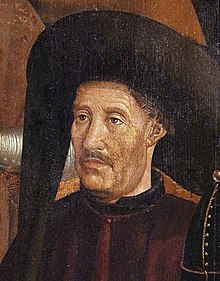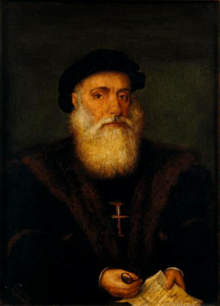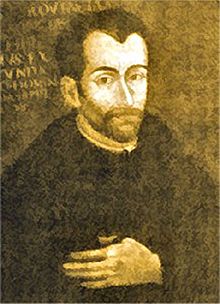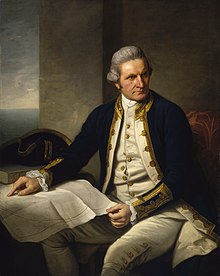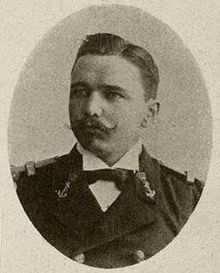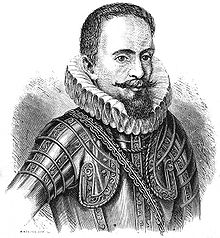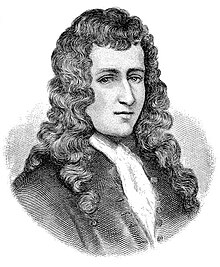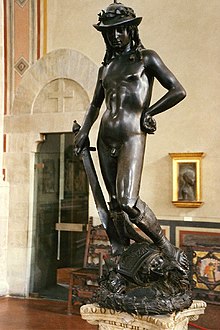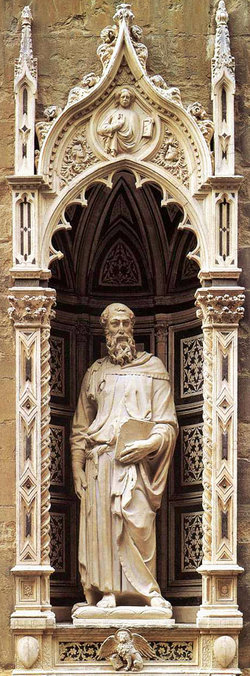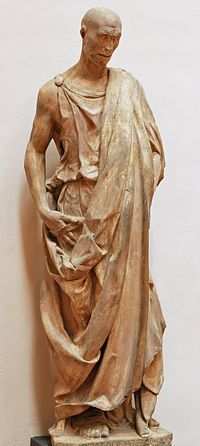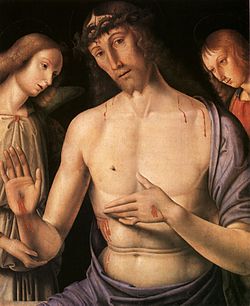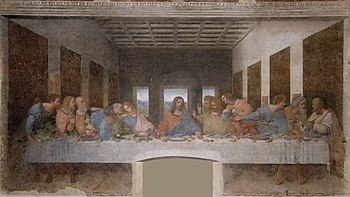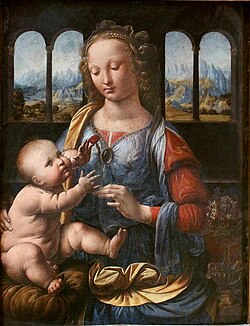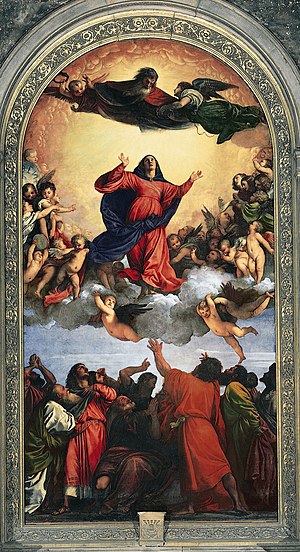Spain

Juan Ponce de León
1474 - 1521
Place of Birth: in the village of Santervás de Campos
Biography: Juan Ponce de León was born in the village of Santervás de Campos in the northern part of what is now the Spanish province of Valladolid. Although early historians placed his birth in 1475, more recent evidence shows he was likely born in 1474. The surname Ponce de León dates from the 13th century. The Ponce de León lineage, comes from Ponce Vélaz de Cabrera descendant of count Bermudo Núñez, and Sancha Ponce de Cabrera, daughter of Ponce Giraldo de Cabrera. Before October 1235, a son of Ponce Vela de Cabrera and his wife Teresa Rodríguez Girón, named Pedro Ponce de Cabrera, married Aldonza Alfonso, an illegitimate daughter of King Alfonso IX of León.The descendants of this marriage added the "de León" to their patronymic and were known henceforth as the Ponce de León.
The identity of his parents is still unknown, but he appears to have been a member of a distinguished and influential noble family. His relatives included Rodrigo Ponce de León, Marquis of Cádiz, a celebrated figure in the Moorish wars.
Ponce de León was related to another notable family, Núñez de Guzmán, and as a young man he served as squire to Pedro Núñez de Guzmán, Knight Commander of the Order of Calatrava.A contemporary chronicler, Gonzalo Fernández de Oviedo y Valdés, states that Ponce de León became an experienced soldier fighting in the Spanish campaigns that defeated the Moors in Granada and completed the re-conquest of Spain in 1492.
Legacy: He led the first European expedition to Florida, which he named. He is associated with the legend of the Fountain of Youth, reputed to be in Florida.

Ferdinand Magellan
1480 - 1521
Place of Birth: Sabrosa, Trás-os-Montes e Alto Douro, Portugal
Biography: Magellan was born in northern Portugal in around 1480, either at Vila Nova de Gaia, near Porto, in Douro Litoral Province, or at Sabrosa, near Vila Real, in Trás-os-Montes e Alto Douro Province. He was the son of Rodrigo de Magalhães, Alcaide-Mor of Aveiro (1433–1500, son of Pedro Afonso de Magalhães and wife Quinta de Sousa) and wife Alda de Mesquita and brother of Leonor or Genebra de Magalhães, wife with issue of João Fernandes Barbosa. After the death of his parents during his tenth year, he became a pageto Queen Leonor at the Portuguese royal court because of his family's heritage.
In March 1505 at the age of 25, Magellan enlisted in the fleet of 22 ships sent to host D. Francisco de Almeida as the first viceroy of Portuguese India. Although his name does not appear in the chronicles, it is known that he remained there eight years, in Goa, Cochin and Quilon. He participated in several battles, including the battle of Cannanore in 1506, where he was wounded. In 1509 he fought in the battle of Diu.He later sailed under Diogo Lopes de Sequeira in the first Portuguese embassy to Malacca, with Francisco Serrão, his friend and possibly cousin.In September, after arriving at Malacca, the expedition fell victim to a conspiracy ending in retreat. Magellan had a crucial role, warning Sequeira and saving Francisco Serrão, who had landed.These actions earned him honors and a promotion.
In 1511, under the new governor Afonso de Albuquerque, Magellan and Serrão participated in the conquest of Malacca. After the conquest their ways parted: Magellan was promoted, with a rich plunder and, in the company of a Malay he had indentured and baptized Enrique of Malacca, he returned to Portugal in 1512. Serrão departed in the first expedition sent to find the "Spice Islands" in the Moluccas, where he remained. He married a woman from Amboina and became a military advisor to the Sultan of Ternate, Bayan Sirrullah. His letters to Magellan would prove decisive, giving information about the spice-producing territories.
After taking a leave without permission, Magellan fell out of favour. Serving in Morocco, he was wounded, resulting in a permanent limp. He was accused of trading illegally with the Moors. The accusations were proved false, but he received no further offers of employment after 15 May 1514. Later on in 1515, he got an employment offer as a crew member on a Portuguese ship, but rejected this. In 1517 after a quarrel with King Manuel I, who denied his persistent demands to lead an expedition to reach the spice islands from the east (i.e., while sailing westwards, seeking to avoid the need to sail around the tip of Africa), he left for Spain. In Seville he befriended his countryman Diogo Barbosa and soon married his daughter by his second wife María Caldera Beatriz Barbosa.They had two children: Rodrigo de Magalhães and Carlos de Magalhães, both of whom died at a young age. His wife died in Seville around 1521.
Meanwhile, Magellan devoted himself to studying the most recent charts, investigating, in partnership with cosmographer Rui Faleiro, a gateway from the Atlantic to the South Pacific and the possibility of the Moluccas being Spanish according to the demarcation of the Treaty of Tordesillas.
Legacy: The Magellanic penguin is named after him, as he was the first European to note it. Magellan's navigational skills have also been acknowledged in the naming of objects associated with the stars, including the Magellanic Clouds, now known to be two nearby dwarf galaxies; the twin lunar craters of Magelhaens and Magelhaens A; and the Martian crater of Magelhaens.

Christopher Columbus
1451 - 1506
Place of Birth: Genoa, Republic of Genoa
Biography: The name Christopher Columbus is the Anglicisation of the Latin Christophorus Columbus. His name in Italian is Cristoforo Colombo, and in Spanish, it is Cristóbal Colón. Columbus was born before 31 October 1451 in the territory of the Republic of Genoa (now part of modern Italy), though the exact location remains disputed. His father was Domenico Colombo, a middle-class wool weaver who worked both in Genoa and Savona and who also owned a cheese stand at which young Christopher worked as a helper. Christopher's mother was Susanna Fontanarossa. Bartolomeo, Giovanni Pellegrino, and Giacomo were his brothers. Bartolomeo worked in a cartography workshop in Lisbon for at least part of his adulthood. He also had a sister named Bianchinetta.
Legacy: Though Christopher Columbus came to be considered the "discoverer of America" in US and European popular culture, his true historical legacy is more nuanced. America was first discovered by its indigenous population, and Columbus was not even the first European to reach its shores as he was preceded by the Vikings at L'Anse aux Meadows. But the lasting significance of Columbus' voyages outshone that of his Viking predecessors, because he managed to bring word of the continent back to Europe. By bringing the continent to the forefront of Western attention, Columbus initiated the enduring relationship between the Earth's two major landmasses and their inhabitants. "Columbus' claim to fame isn't that he got there first," explains historian Martin Dugard, "it's that he stayed."
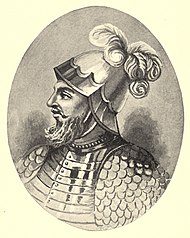
Vasco Núñez de Balboa
1475 - 1519
Place of Birth: Jerez de los Caballeros,Badajoz, Spain
Biography: Balboa was born in Jerez de los Caballeros, Spain. He was a descendant of the lord mason of the castle of Balboa, which is located in northwestern Spain. His mother was the Lady de Badajoz, and his father was the hidalgo (nobleman), Nuño Arias de Balboa. Little is known of his early childhood except that he was the third of four boys in his family. During his adolescence, he served as a page and squire to Don Pedro de Portocarrero, lord of Moguer.
Legacy: Vasco Nunez de Balboa was featured on the 1-cent denomination of the Panama-Pacific Exposition of 1913. The 1-cent Balboa paid the one-cent card rate, and it was used in combination with other denominations to meet large weight and foreign destinations. The Bureau of Engraving and Printing issued over 330 million of these to the public.
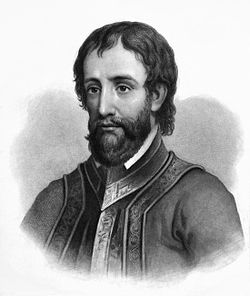
Hernando de Soto
1496 or 1498 or 1500 - 1542
Place of Birth: Jerez de los Caballeros,Badajoz, Extremadura, Spain
Biography: Hernando de Soto was born to parents who were hidalgos of modest means in Extremadura, a region of poverty and hardship from which many young people looked for ways to seek their fortune elsewhere. He was born in Jerez de los Caballeros, in the current province of Badajoz. However, three towns—Badajoz, Barcarrota and Jerez de los Caballeros—claim to be his birthplace. He spent time as a child at each place, and he stipulated in his will that his body be interred at Jerez de los Caballeros, where other members of his family were interred. The age of the Conquerors came on the heels of the Spanish reconquest of the Iberian peninsula from Islamic forces. Spain and Portugal were filled with young men seeking a chance for military fame after the Moors were defeated. With discovery of new lands to the west (which they thought at the time to be East Asia), they were attracted to whispers of glory and wealth.
De Soto sailed to the New World with the first Governor of Panama, Pedrarias Dávila. In 1520 he participated in Gaspar de Espinosa's expedition to Veragua, and in 1524, he participated in the conquest of Nicaragua under Francisco Hernandez de Cordoba. There he acquired an encomienda and a public office in Leon, Nicaragua.
Brave leadership, unwavering loyalty, and ruthless schemes for the extortion of native villages for their captured chiefs became de Soto's hallmarks during the Conquest of Central America. He gained fame as an excellent horseman, fighter, and tactician.
During that time, de Soto was influenced by the achievements of Juan Ponce de León, who discovered Florida; Vasco Núñez de Balboa, who discovered the Pacific Ocean (he called it the "South Sea" on the south coast of Panama), and Ferdinand Magellan, who first sailed that ocean to the Orients
Legacy:a Spanish explorer and conquistador who led the first European expedition deep into the territory of the modern-day United States (Florida, Georgia, Alabama and most likely Arkansas), and the first documented European to have crossed the Mississippi River.
